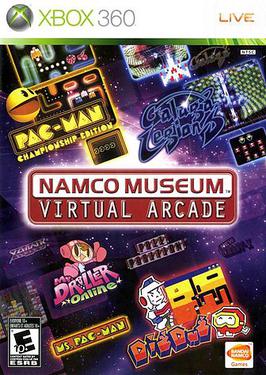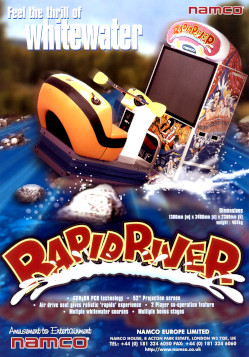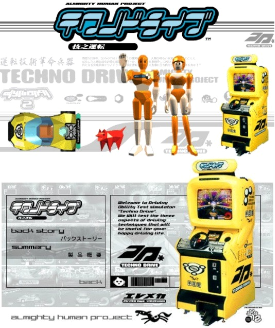
Namco Limited is a dormant subsidiary owned by Bandai Namco Holdings that used to be a Japanese multinational video game and entertainment company, headquartered in Ōta, Tokyo. It held several international branches, including Namco America in Santa Clara, California, Namco Europe in London, Namco Taiwan in Kaohsiung, and Shanghai Namco in mainland China.

Ace Combat 04: Shattered Skies is a 2001 combat flight simulation video game developed and published by Namco for the PlayStation 2. It is the fourth entry in the Ace Combat series and the first in the series to be released for the PlayStation 2. The game's plot, set in a fictional alternate universe where Earth has been ravaged by asteroid impacts, follows the player character "Mobius 1", a fighter pilot in a multinational military coalition who spearheads the liberation of the fictional continent of Usea from the expansionist country of Erusea.
Ace Combat is an arcade-style combat flight simulation video game series by Project Aces, an internal development team of Bandai Namco Entertainment, formerly Namco. Debuting in 1995 with Air Combat for the PlayStation, the series includes eight mainline installments, multiple spin-offs, and other forms of media, such as novels, model kits, and soundtrack albums. Since 2012, the series has been developed primarily by Bandai Namco Studios through its internal development group, Project Aces.

Air Combat is a 1995 combat flight simulation video game developed and published by Namco for the PlayStation. Players control an aircraft and are tasked with completing a series of missions, with objectives ranging from destroying formations of enemies to protecting a specific target from enemy fire. Missions award money that is used to purchase new fighter aircraft, each with its own unique weapons and strengths.

Bakutotsu Kijūtei, also known by its longer title as Bakutotsu Kijūtei: Baraduke II, is a scrolling shooter arcade game that was released by Namco in 1988 only in Japan, and for the Virtual Console in 2009. It runs on Namco System 1 hardware, and is the sequel to Baraduke, which was released three years earlier. It was also the second game from the company to allow scores not ending in "0", along with the first one to display Katakana in bold text onscreen to distinguish it from Hiragana. The game would later be ported to the Wii Virtual Console in 2009 for Japan only.

Taiko no Tatsujin is a video game series created by Namco. In the games, players simulate playing a taiko drum in time with music. The series has released games for the arcade and for console and mobile platforms including PlayStation 2, Advanced Pico Beena, PlayStation Portable, Nintendo DS, Wii, Nintendo 3DS, Wii U, PlayStation Vita, PlayStation 4, Nintendo Switch, Xbox One, Xbox Series X/S, Microsoft Windows, iOS, Android and Japanese feature phones.

Bandai Namco Entertainment Inc. is a Japanese multinational video game publisher owned by Bandai Namco Holdings. It was founded in 2006 as Namco Bandai Games Inc., following the 2005 merger of Namco and Bandai. Namco acquired Bandai's video game business division through a corporate split. In 2009, Bandai Namco Games absorbed Bandai Networks. It is headquartered in Minato, Tokyo.

Kidō Senshi Gundam: Senjō no Kizuna, is a Japanese arcade game set in the original Gundam universe. The game was created by Bandai Namco and Banpresto and was released late 2006. Play involves stepping into a P.O.D. and doing battle with other players across Japan.

Namco Museum Virtual Arcade is a video game compilation developed and published by Namco Bandai Games for the Xbox 360. It was released in North America in 2008 and in Europe and Japan in 2009. Part of its Namco Museum series, Virtual Arcade includes 34 titles; nine of these are Namco Bandai-published Xbox Live Arcade games, and the rest are arcade games that are only accessible through the disc. Players can access the Xbox Live Arcade games through their dashboard if the disc is in the console.

Tank! Tank! Tank! is a 2009 third-person shooter arcade game developed and published by Namco Bandai Games. It was ported to the Wii U in 2012, where it was a system launch title in North America. Players control their respective tanks and must destroy opponents and giant mechanical monsters with a variety of weapons, such as machine guns and rocket launchers. Its gameplay has been compared to titles such as the Earth Defense Force series, through its usage of B-movie tropes and parodying.
The Idolmaster is a Japanese media franchise that began in 2005 with a raising simulation and rhythm video game series created by Bandai Namco Entertainment. The series primarily centers on the career of a producer who works with a group of prospective pop idols at the talent agency 765 Production. Originally released as an arcade game, the franchise has grown to numerous ports, sequels and spin-offs across multiple video game consoles, including several social network games. The series includes a variety of other media such as an anime with the same name, printed media, audio dramas, a Korean drama, and radio shows.

Bandai Namco Studios Inc. is a Japanese video game developer headquartered in Kōtō, Tokyo. Its offices in Malaysia and Singapore, Bandai Namco Studio Malaysia and Bandai Namco Studios Singapore, are based out of Selangor, Malaysia and Infinite Studios, Singapore respectively. Bandai Namco Studios is a subsidiary of Bandai Namco Entertainment, which itself is a subsidiary of Bandai Namco Holdings. The company works under its parent company as a keiretsu; Bandai Namco Studios creates video games for home consoles, handheld systems, mobile devices and arcade hardware, while Bandai Namco Entertainment handles the managing, marketing and publishing of these products.

Air Combat is a 1993 combat flight simulator arcade video game developed by Namco. The arcade game was released in 1993 for the polygon-powered Namco System 21 arcade hardware, and received praise for its 3D graphics and technological capabilities. The game was a commercial success at Japanese and American arcades in the 1990s, and inspired several later Namco games, including the arcade sequel Air Combat 22, the PlayStation game Air Combat, and the Ace Combat series.

Rapid River is a 1997 arcade game released by Namco. The game is about white water rafting, and players must race against the clock, passing through checkpoints to extend the time they have to complete the level. The game is notable for its unique player controls that aim to replicate oars. It was intended to appeal to dating couples. The game is one of only two known games to run on Namco Gorgon hardware, an early revision of the Namco System 23 hardware. A virtual reality remake was released by Bandai Namco Amusement in 2018 for its VR Zone arcade centers.

Starblade: Operation Blue Planet is an unreleased 3D rail shooter arcade game in development by Namco. A sequel to the game Starblade (1991), the player controls the GeoCalibur starship in its mission to wipe out an alien race known as the Unknown Intelligent Mechanized Species. Gameplay involved using a flight-yoke controller to control a crosshair and shoot down enemies, while avoiding incoming obstacles and projectiles. The player has a shield that depletes when inflicted with enemy fire. Only one level was completed. It ran on the PlayStation 2-based Namco System 246 arcade hardware.

Techno Drive is a 1998 driving simulator arcade game developed and published by Namco in Japan. It is known for its unique graphical interface that uses fluorescent colors choices and flat shading. Players control a racecar throughout a variety of different minigames, each testing their skill and reaction time. Minigames include drifting along corners, avoiding collision with other vehicles, and driving with a bowl of liquid attached to the rear of the car. The game was designed for the Namco System 12, an arcade board based on raw PlayStation hardware.
















